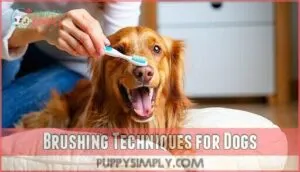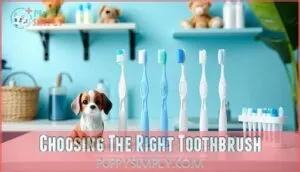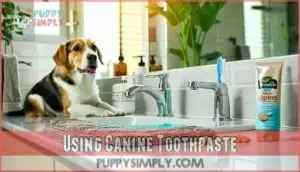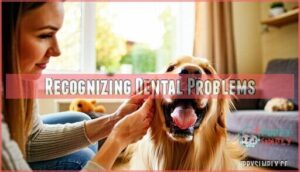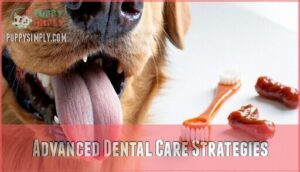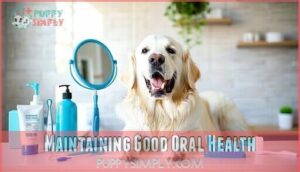This site is supported by our readers. We may earn a commission, at no cost to you, if you purchase through links.
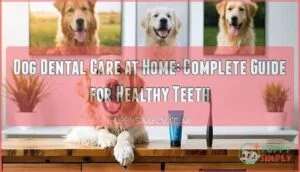
The good news? You don’t need expensive equipment or professional training to protect your dog’s teeth. A consistent at-home dental care routine, starting with just a few minutes of daily brushing, creates a powerful defense against periodontal disease and keeps your dog comfortable for years to come.
This guide walks you through the essential techniques and tools that make dog dental care at home both effective and manageable.
Table Of Contents
- Key Takeaways
- Dog Dental Care Basics
- Daily Dental Care Routine
- Dietary Considerations
- Recognizing Dental Problems
- Advanced Dental Care Strategies
- Maintaining Good Oral Health
- Frequently Asked Questions (FAQs)
- How do I take care of my dog’s teeth at home?
- How can I treat my dog’s rotten teeth at home?
- Is it too late to clean dogs’ teeth?
- Can you scrape plaque off your dog’s teeth at home?
- How can I clean my dog’s teeth without going to the vet?
- How can I get plaque off my dog’s teeth?
- What is the best thing to clean dogs’ teeth?
- Can I use human toothpaste?
- Whats better, dental treats or dental chews?
- How often should I brush my dogs teeth?
- Conclusion
Key Takeaways
- Daily brushing with dog-specific toothpaste is your most powerful defense against periodontal disease, which affects 80% of dogs by age three and can damage vital organs like the heart and kidneys if left untreated.
- Early intervention through consistent at-home dental care catches reversible gingivitis before it progresses to permanent bone loss, tooth extractions, and systemic infections that compromise your dog’s overall health.
- Professional veterinary cleanings once or twice yearly (depending on breed size and risk factors) reach hidden plaque beneath the gumline that home brushing can’t address, making them essential even when you maintain a solid daily routine.
- Warning signs like persistent bad breath, difficulty chewing, red or bleeding gums, and behavioral changes (pawing at the mouth or avoiding hard foods) signal dental problems requiring immediate veterinary attention before they escalate into painful, costly emergencies.
Dog Dental Care Basics
Your dog’s dental health deserves attention long before problems become visible. By understanding why early care matters, what issues commonly develop, and how they affect your pet’s overall wellbeing, you’ll be equipped to protect those teeth from day one.
Let’s explore the three essential foundations of canine dental care.
Importance of Early Intervention
By three years old, 80% of dogs already show signs of dental disease—but catching problems early transforms your dog’s health trajectory and saves you from heartbreak down the road. Early detection through preventive measures means you’ll spot reversible gingivitis before it causes permanent damage. At-home dental care combined with veterinary guidance creates a powerful defense against dental disease progression.
Eighty percent of dogs show dental disease by age three, but early detection stops reversible gingivitis before permanent damage occurs
Here’s what preventative veterinary care accomplishes for canine oral hygiene:
- Stops disease before it starts – Dental awareness helps you catch Stage 1 issues while they’re still reversible
- Protects essential organs – Dental disease prevention keeps harmful bacteria from reaching your dog’s heart, liver, and kidneys
- Reduces long-term costs – Pet insurance data shows preventive measures cost far less than emergency extractions
- Makes training easier – Puppies accept brushing routines more readily than adult dogs
- Ensures comfort – Dog dental health maintenance prevents chronic pain that affects eating and quality of life
Common Dental Issues in Dogs
Understanding what threatens your dog’s dental health helps you protect them effectively. Periodontal disease affects at least 80% of dogs over three, damaging gums and bone supporting teeth—smaller breeds face even higher risk.
You’ll also encounter dental calculus (hardened plaque) in nearly 40% of dogs, plus tooth fractures affecting 37.5% of certain breeds. Caries appear in about 5% of dogs, while bad breath signals oral infections needing attention.
These dental problems don’t just cause discomfort—they’re doorways to serious health complications affecting your dog’s heart, liver, and kidneys. Regular veterinary checkups can help identify periodontal disease risks and prevent further complications.
Consequences of Poor Dental Health
When dental disease takes hold, your dog faces health threats that extend far beyond a sore mouth. Bacteria from plaque buildup and tartar buildup don’t stay put—they invade the bloodstream, triggering systemic infections that compromise essential organs:
- Heart problems develop as bacteria attach to heart valves, increasing cardiac disease risk sixfold
- Kidney failure occurs when toxins overwhelm filtration systems
- Liver disease emerges from constant bacterial assault
- Severe periodontal disease causes painful tooth loss and eating difficulties
Don’t let gum disease steal your dog’s quality of life—these dog dental health problems are preventable with consistent care.
Daily Dental Care Routine
Building a solid home care routine doesn’t have to feel overwhelming. Once you establish the right daily habits, protecting your dog’s teeth becomes second nature.
Let’s walk through the essential tools and techniques that’ll make brushing effective and stress-free for both of you.
Brushing Techniques for Dogs
Think of brushing your dog’s teeth like teaching them any new skill—patience and consistency turn resistance into routine. Start by letting your dog taste the toothpaste, then gently lift their lip and use small circular motions along the gum line. Focus on the outer surfaces of the back molars, where tartar builds up most.
Short, positive sessions work best for canine dental health. End before your dog gets frustrated to keep pet hygiene routines stress-free.
| Brushing Frequency | Technique Focus | Session Length |
|---|---|---|
| Daily (ideal) | Circular motions at gum line | 30-60 seconds |
| 3x weekly (minimum) | Outer tooth surfaces | Start with 15 seconds |
| Gradual introduction | Taste, touch, then brush | Build up slowly |
Choosing The Right Toothbrush
Not all toothbrushes are created equal, and the wrong one can turn brushing sessions into a wrestling match your dog will win. Dog-specific toothbrushes feature softer bristles that won’t irritate sensitive gums while effectively removing plaque. Grip designs range from long-gripped brushes for better reach to finger brushes that give you more control with anxious pets.
Here’s what to keep in mind when selecting your toothbrush:
- Brush sizes match your dog’s mouth—Chihuahuas need smaller heads than German Shepherds to access those back molars comfortably.
- Bristle types should be soft enough to protect gums but firm enough to scrub away debris during brushing.
- Comfortable grips reduce hand fatigue and give you better control during dog dental care at home.
The right toothbrush transforms dental hygiene from struggle to routine.
Using Canine Toothpaste
Your dog’s toothpaste should taste like dinner, not mint—and that’s exactly what canine formulas deliver with flavors like chicken, beef, and peanut butter.
These enzyme-based toothpaste ingredients break down plaque naturally while keeping your dog excited for dog teeth cleaning sessions. Human toothpaste contains xylitol and fluoride—both toxic to dogs—so veterinary toothpaste is non-negotiable for safe canine dental hygiene.
Apply a pea-sized amount to your brush and you’re ready to protect your dog’s oral health without worrying about harmful ingredients.
Dietary Considerations
What you feed your dog plays a direct role in their oral health. The right dietary choices can help reduce plaque buildup, while the wrong ones can accelerate dental disease.
Let’s look at how to make food work for your dog’s teeth, not against them.
Balanced Diet for Dental Health
What you feed your dog goes beyond filling their bowl—it shapes their mouth’s entire ecosystem. Nutrient balance matters because calcium, phosphorus, and vitamin D work together to keep tooth enamel strong and gums resilient.
Food texture plays a surprising role, too. Dry kibble’s abrasive action scrapes away plaque as your dog chews, while wet food can allow bacteria to flourish. That’s where oral microbiota comes in—dogs eating crunchy foods develop healthier bacterial populations in their mouths.
Enzyme effects from fresh ingredients also help break down biofilm before it hardens into tartar, supporting canine dental care naturally through smart diet choices. A well-planned raw diet approach can markedly reduce the risk of periodontal disease in dogs.
Dental-Specific Diets and Treats
Specialty dental products work like a targeted cleaning crew, tackling plaque and tartar where your toothbrush can’t always reach. Veterinary diets engineered for dog oral care feature larger kibbles that scrub tooth surfaces during chewing—think of them as edible toothbrushes. Dental chews with VOHC approval reduce plaque by up to 44%, while oral supplements containing enzymes break down bacterial films before they harden. These diet choices support pet nutrition and health beyond basic feeding, especially when you’re balancing calorie control with dental benefits.
Five game-changing dental treats that actually work:
- Greenies – Textured ridges scrape away buildup while your dog enjoys the taste
- DentaLife – Porous texture reaches back teeth where disease often starts
- Veggiedent – Plant-based option for protein-sensitive dogs who need oral care
- Whimzees – Natural ingredients with shapes that encourage longer chewing time
- Prescription dental kibble – Veterinarian-recommended nutrition plans for severe periodontal concerns
Avoiding Harmful Foods and Substances
Some foods act like silent saboteurs, slowly eroding your dog’s dental health from the inside out while appearing harmless at first glance. Human toothpaste containing xylitol tops the Toxic Food List—even small amounts damage gums and enamel. Sticky table scraps cling to teeth, feeding harmful bacteria that trigger inflammation, particularly dangerous for dogs with food allergens. Hard bones and ice cubes crack teeth despite seeming tooth-friendly. Certain poisonous plants like sago palm cause oral lesions when chewed.
Focus your diet choices on veterinary-approved options that support dog dental health and pet nutrition and health, protecting your dog’s oral health through proper dog oral care while avoiding Bad Ingredients and Harmful Substances.
Recognizing Dental Problems
Catching dental problems early can save your dog from pain and prevent serious health complications down the road.
You’ll want to know what to look for during your regular home inspections, from subtle changes in behavior to visible signs in the mouth. Here’s what signals trouble and when it’s time to call your vet.
Warning Signs of Dental Issues
Think of your dog’s mouth as a warning system—it broadcasts problems long before they become painful emergencies. Nearly half of all dogs show bad breath causes linked to bacterial buildup, and up to 80% develop gum disease by age two. Catching these dental problems early protects not just oral health, but your dog’s heart, liver, and kidneys from infection risks.
Watch for these clear indicators that your dog needs veterinary attention:
- Persistent bad breath with a foul or fishy odor, signaling bacteria and tartar buildup beneath the gumline
- Changes in eating habits like dropping food, chewing slowly, or suddenly preferring soft foods over crunchy treats
- Visible tooth discoloration including brown or yellow staining, bleeding gums, or loose teeth
- Behavioral shifts such as pawing at the mouth, excessive drooling, or pulling away when you touch their face
These oral pain signs often appear gradually, making regular home inspections essential for preventing plaque accumulation from escalating into serious dental infection risks.
Identifying Periodontal Disease
Periodontal disease doesn’t just appear overnight—it sneaks up through stages, starting with gingivitis that many owners mistake for normal aging. Understanding these periodontal stages helps you catch problems before they threaten your dog’s overall health. Here’s what to look for as dental hygiene deteriorates:
| Stage | Gingivitis Symptoms | Visible Changes |
|---|---|---|
| Early Gingivitis | Red, swollen gumline; minor bleeding during brushing | Mild plaque and tartar along teeth |
| Moderate Periodontitis | Receding gums; persistent bad breath | Gum recession exposing tooth roots; pockets forming |
| Late Periodontitis | Loose teeth; painful chewing; oral infections | Severe bone loss visible on dental X-rays |
| Severe Disease | Tooth loss; facial swelling; systemic risks | Deep pockets; abscesses; heart/kidney complications |
Regular veterinary dentistry checkups with professional cleanings catch periodontal disease early, protecting your dog from unnecessary pain and expensive treatments down the road.
Detecting Tooth Decay and Broken Teeth
While gum disease gets most of the attention, cavities and fractures cause just as much pain—and they’re easier to miss until your dog’s already hurting. Check your dog’s teeth weekly for these red flags:
- Dark spots or discoloration – Brown or black marks signal tooth decay breaking down enamel
- Visible chips or cracks – Tooth fractures from chewing hard objects need immediate attention
- Exposed roots from gum recession – A sign dental problems are advancing
- Chewing on one side only – Pain makes dogs avoid the affected area
- Worn or eroded surfaces – Chronic chewing damages protective tooth layers
Dental x-rays during professional cleanings reveal hidden fractures beneath the gumline that you can’t spot with a toothbrush alone.
Advanced Dental Care Strategies
Beyond daily brushing, you can add extra layers of protection to your dog’s dental routine.
Water additives, specialized chews, and alternative cleaning tools offer practical ways to support oral health between brushings.
Let’s look at these supplemental strategies that can make a real difference in preventing plaque and keeping your dog’s mouth healthier.
Water Additives for Fresh Breath
Water additives serve as a simple ally in dog dental care at home, fighting bacteria that trigger bad breath and dental plaque reduction. You simply pour these VOHC-approved solutions into your pet’s water bowl daily, and they get to work reducing plaque by over 40% within 30 days while delivering fresh breath solutions for up to 12 hours.
Clinical trials show dogs using water additives achieve notably lower plaque scores compared to controls, with pet owner compliance reaching 60% due to convenience. These oral health benefits work best after professional cleanings, supporting your dog’s oral hygiene without the daily brushing battle.
Dental Chews and Treats
Beyond water additives, dental chews give your dog something they’ll actually enjoy while scraping away plaque through natural chewing action. Look for VOHC-approved dental treats with textured surfaces that mechanically remove debris while your dog satisfies their natural chewing instincts. These pet dental products deliver real oral health benefits when you make them part of your routine.
Consider these effective dental chew options:
- Enzymatic Chews – Break down tartar naturally with ingredients like glucose oxidase
- Textured Dental Treats – Ridged surfaces massage gums and scrape teeth during chewing
- Size-Appropriate Products – Match chew textures to your dog’s breed for sustained cleaning action
Veterinary recommendations emphasize keeping dental chews under 10% of daily calories to maintain balanced nutrition while supporting dog teeth cleaning.
Alternative Cleaning Methods
When your dog won’t sit still for brushing or you need backup options between cleaning sessions, you’ll find plenty of practical alternatives that get the job done. Dental wipes offer gentle cleaning for sensitive mouths, while enzyme cleaners break down plaque without scrubbing. Oral sprays reach tight spaces easily, and water additives turn every drink into passive dental care.
Some owners explore ultrasonic cleaners or water flossers for at-home dog teeth cleaning, though these require careful introduction and veterinary guidance before use.
Maintaining Good Oral Health
Once you’ve established a solid dental care routine, the real challenge is sticking with it long-term. Your dog’s oral health depends on consistency—regular brushing, timely professional cleanings, and catching problems early before they escalate.
Let’s look at the three key practices that keep your dog’s teeth healthy for years to come.
Regular Brushing and Care
Your dog’s mouth harbors the same bacteria that thrive in your own, and without regular brushing, that invisible army quietly launches an attack on teeth and gums every single day. Daily maintenance isn’t just about fresh breath—it’s your first line of defense against painful infections and costly extractions.
Brushing techniques matter more than you might think, so here’s what works:
- Start slow – Let your pup taste the toothpaste before introducing the brush
- Use gentle circles – Focus on the gum line where plaque builds up fastest
- Target back teeth – Molars accumulate more debris than front teeth
- Keep it brief – Two minutes prevents stress and builds positive associations
- Reward immediately – Treats after each session make oral hygiene something they’ll tolerate, even enjoy
Consistency transforms dog dental care at home from chore into habit.
Scheduling Professional Cleanings
Regularly scheduled professional cleanings reach the hidden battlegrounds beneath your dog’s gumline, where even the best home care can’t follow. Most dogs benefit from veterinary dentistry visits once every twelve months, though small breeds typically need professional consultations twice yearly because their compact mouths make them vulnerable to faster disease progression.
Cleaning frequency depends on breed size, age, and how consistently you maintain preventative care at home—dogs with daily brushing routines often stretch intervals between appointments, while older or high-risk pets require closer veterinary scheduling.
Dental costs range from $300 to $1,000 for routine cleanings, climbing higher when extractions become necessary. Anesthesia risks concern many owners, but mortality rates sit at just 0.05% for healthy dogs thanks to thorough pre-procedure bloodwork and continuous monitoring. Your veterinarian establishes tailored schedules based on individual oral health assessments during regular checkups.
Monitoring Dental Health and Preventing Issues
Catching dental problems before they escalate starts with routine home inspections—a simple habit that takes less than a minute but can save your dog from painful extractions down the road. Lift your dog’s lips weekly to check for plaque buildup, inflamed gums, or broken teeth.
Watch for warning signs like persistent bad breath, difficulty chewing, or pawing at the mouth—these red flags signal gum disease requiring immediate attention.
Consistent oral inspections paired with daily at-home dog teeth cleaning create your strongest defense against preventable dental diseases in dogs.
Frequently Asked Questions (FAQs)
How do I take care of my dog’s teeth at home?
Brushing daily with dog-specific toothpaste forms the foundation of at-home dental care. Use a soft-bristled brush designed for pets, start gradually with positive reinforcement, and supplement with VOHC-approved dental chews to reduce plaque buildup between brushing sessions.
How can I treat my dog’s rotten teeth at home?
Unfortunately, home remedies and natural cures can’t reverse rotten teeth or treat severe decay. At-home dog teeth cleaning helps prevent tartar buildup, but once tooth rot sets in, professional veterinary extraction or treatment becomes necessary.
Dog mouthwash and oral supplements support healthy dog teeth—they don’t fix existing damage.
Is it too late to clean dogs’ teeth?
It’s never too late to start maintaining dog oral health, though late-stage cleaning requires extra care.
Even senior dogs with existing gum disease management challenges benefit from daily brushing and professional Pet Dental Recovery protocols.
Starting at-home dog teeth cleaning now can slow teeth restoration needs and improve comfort, no matter your dog’s age.
Can you scrape plaque off your dog’s teeth at home?
At-home plaque scraping isn’t safe—you risk damaging enamel or injuring gums without proper training. Hardened tartar requires professional dental scaling by your veterinarian.
Instead, focus on daily brushing with dog-specific toothpaste for effective plaque control and oral hygiene between professional cleanings.
How can I clean my dog’s teeth without going to the vet?
Can you keep your dog’s smile healthy without a vet visit? Daily teeth brushing with dog toothpaste and a soft brush directly addresses plaque, while VOHC-approved dental chews provide mechanical cleaning between sessions.
Dental wipes and oral rinses offer gentler alternatives when brushing isn’t possible.
How can I get plaque off my dog’s teeth?
Daily brushing with dog-specific toothpaste is your most effective weapon against plaque buildup.
For stubborn deposits, dental wipes, VOHC-approved chews, and water additives can help between brushing sessions.
Professional tooth scaling removes hardened tartar that home care can’t touch.
What is the best thing to clean dogs’ teeth?
The benchmark for pet oral care? Brushing with a dog toothbrush and canine toothpaste removes plaque before it hardens into tartar.
Professional veterinary cleaning complements your home routine, reaching beneath the gumline where dental hygiene tools can’t access.
Can I use human toothpaste?
Human toothpaste is dangerous for your dog. It contains fluoride and xylitol—both toxic ingredients that can poison your pet.
Even small amounts risk digestive upset or worse. Stick with dog toothpaste formulated specifically for canine oral safety.
Whats better, dental treats or dental chews?
Both dental treats and chews reduce plaque, but chews usually win for tartar control.
Chews offer longer contact time with teeth, providing enhanced mechanical cleaning action. This extended scrubbing makes them particularly effective for plaque prevention and gum disease management in your at-home dog dental care routine.
How often should I brush my dogs teeth?
Only 15% of dog owners brush their pet’s teeth regularly—yet daily brushing is your best defense against dental disease.
Aim to brush your dog’s teeth every day for ideal canine oral health. If that’s not realistic, brushing 2-3 times weekly still provides significant benefits for your pet hygiene routine and at-home dog teeth cleaning efforts.
Conclusion
Picture your dog’s bright-eyed grin—free of pain, infection, and decay. That vision isn’t wishful thinking.
With consistent dog dental care at home, you’re building a foundation that protects not just teeth, but your dog’s heart, kidneys, and quality of life.
Start with a few minutes of daily brushing, remain vigilant for warning signs, and schedule professional cleanings as needed. Your hands hold the tools that determine whether your dog enjoys comfortable, healthy years ahead or suffers silently from preventable disease.
- https://pmc.ncbi.nlm.nih.gov/articles/PMC5773197/
- https://www.prnewswire.com/news-releases/state-of-pet-dental-health-significant-majority-of-us-dogs-and-cats-have-oral-health-issues-302063737.html
- https://www.akcchf.org/disease-history/dental-health-for-dogs/
- https://www.dvm360.com/view/boost-client-pet-dental-care-compliance-with-practical-solutions
- https://www.avma.org/resources-tools/pet-owners/petcare/pet-dental-care

